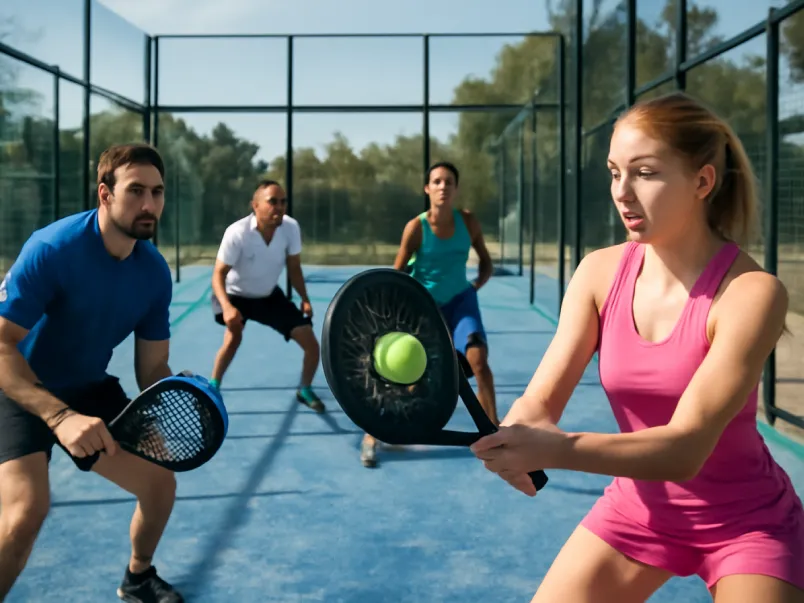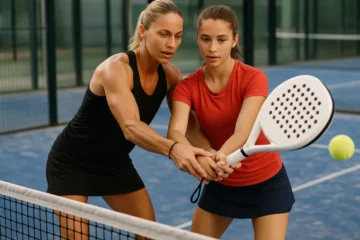Padel is rapidly becoming Europe’s most popular sport, captivating players of all ages across the continent. What started as a niche activity has blossomed into a global phenomenon, with millions of players and growing investments flooding the padel scene. This racket sport, a unique mix of tennis and squash, has sparked a craze that stretches from the sunny beaches of Spain to the northernmost regions of Scandinavia. In this article, we’ll explore why padel is exploding in popularity, its key drivers of growth, and what the future holds for this dynamic and accessible sport.
I. Europe’s New Sporting Obsession
A. The Hook: A Striking Statistic
Padel’s popularity has reached unprecedented heights in Europe, with over 12 million active players on the continent, and it’s showing no signs of slowing down. The sport boasts an annual growth rate of 25%, a figure that underscores its rapidly expanding footprint. What’s fueling this growth? Let’s dive into the reasons why padel is capturing the attention of both casual enthusiasts and dedicated athletes alike.
B. What is Padel?
At its core, padel is a thrilling blend of tennis and squash. Played on an enclosed court roughly a third the size of a traditional tennis court, players use solid paddles (not rackets) and a depressurized ball. The unique setup involves the ball being allowed to bounce off the walls, a feature that keeps rallies alive and intensifies the game. Unlike tennis, which emphasizes powerful serves and baseline play, padel puts a premium on strategy, placement, and teamwork.
C. Thesis Statement
Padel’s explosive rise in Europe can be attributed to its combination of social accessibility, low barrier to entry, and commercial viability. The sport has found its sweet spot in terms of inclusivity, offering an engaging experience for players of all ages and skill levels. Whether played at a competitive level or just for fun with friends, padel delivers a uniquely enjoyable experience that has made it the fastest-growing sport on the continent.
II. The “Perfect Storm” of Accessibility
A. Easy to Learn, Hard to Master
One of the key reasons behind padel’s rapid rise is how accessible it is to new players. Unlike tennis, where it takes years of practice to master the game’s fundamentals, padel is remarkably easy to pick up. Beginners can start playing almost immediately, enjoying rallies and experiencing the thrill of the game within minutes. The rules are simple, the equipment is easy to use, and the compact court design means that players don’t have to run as far or deal with the challenges of a standard tennis court.
A significant factor in the accessibility of padel is the use of the court’s walls. This adds a unique dimension to the game, where players can bounce the ball off the walls to extend rallies, making it more forgiving for beginners. The shorter rallies in padel also mean that new players can quickly experience success, which encourages them to return to the court time and again.
B. A Sport for All: Demographics and Inclusivity
Padel stands out because of its demographic inclusivity. This is a sport that can be played by children, adults, and seniors alike. Its accessibility means that players of different generations can share the court together, making it a family-friendly sport. Additionally, the emphasis is less on physical prowess and more on strategy, which appeals to both men and women.
The game’s popularity is also evident in the fact that padel is predominantly played in doubles, fostering a highly social atmosphere. Players work as a team, communicate, and support one another, creating a unique camaraderie that’s not often seen in other sports. This social dynamic is one of the main reasons why padel has quickly established itself as more than just a sport—it’s become an event, a chance for people to meet up, chat, and enjoy a fun time together.
C. The Social Catalyst: Padel as a Social Event
Padel’s double format and smaller court design make it inherently social. Unlike tennis, where players are often isolated on opposite sides of the court, padel players are positioned closer together, making conversation and interaction a natural part of the game. This social element has made it a favorite pastime for groups of friends, colleagues, and families looking for a fun, active way to spend time together.
Moreover, padel courts are often situated in highly accessible locations, from city centers to beachfront resorts, further cementing the sport’s appeal as a social activity. Whether it’s a group of friends enjoying a weekend match or coworkers engaging in a corporate challenge, padel’s friendly, welcoming nature helps foster a positive social environment.
III. The Engine of Growth: Key Drivers
A. Celebrity and Athlete Endorsements: The “Influencer” Effect
One of the driving forces behind padel’s rise is the involvement of high-profile athletes and celebrities. Icons like Lionel Messi, Cristiano Ronaldo, and Serena Williams have all publicly supported padel, either by playing the sport or investing in padel clubs. These endorsements have played a pivotal role in raising the sport’s profile, turning it into a cultural trend. The media coverage surrounding these celebrities has drawn attention to padel, attracting fans who may have never considered picking up a racket before.
B. Commercial Investment & Club Boom: The Business Case for Padel
Padel’s growth is also driven by its strong commercial viability. The construction of padel courts is considerably cheaper than tennis courts, making it an attractive investment for club owners and developers. As demand for the sport continues to surge, real estate developers have incorporated padel courts as amenities in new residential complexes. This has created a sustainable model for business growth while simultaneously meeting the demand from players eager to find more places to play.
Additionally, the quick game turnover and the ability to host multiple matches per day mean that padel clubs can generate substantial revenue. Many clubs operate with high membership rates and hold regular tournaments, further boosting their profits. This commercial success has spurred the construction of more padel courts, increasing access to the sport and contributing to its exponential growth.
C. Effective Media Coverage & Professionalization
The rise of professional padel has also played a key role in its expansion. With the creation of global competitions like the World Padel Tour and Premier Padel, the sport has gained significant media coverage. These professional leagues have raised the level of play, attracted top-tier athletes, and garnered television deals, ensuring that padel continues to reach a broader audience.
As padel grows, the sport is experiencing a greater degree of professionalism, with sponsors, partnerships, and dedicated media coverage helping to establish padel as a mainstream sport.
IV. The European Epicenter and Its Ripple Effect
A. Case Study: Spain – The Birthplace and Blueprint
While padel originated in Mexico in the 1960s, it was in Spain that the sport truly flourished. Spain is home to the world’s largest padel market, with the sport being the second most popular sport after football. The country’s vast network of clubs and world-class players has created a strong foundation for padel to grow across Europe.
The success of padel in Spain has provided a blueprint for other countries looking to replicate this growth. The combination of government support, infrastructure investment, and a vibrant padel culture has made Spain the epicenter of European padel. The country’s dominance in the sport continues to inspire nations across Europe to follow suit.
B. The Northern Expansion: Scandinavia and Beyond
Padel is not only growing in Spain; it has also taken off in northern Europe. Countries like Sweden, Finland, and the Netherlands have seen a rapid adoption of the sport, fueled by the availability of indoor courts and pop-up facilities that allow play year-round, regardless of the weather. Scandinavia, in particular, has embraced the sport with open arms, and its growth in these regions has created a ripple effect across the continent.
C. Conquering New Territories
Padel’s appeal is spreading to other European countries as well, including the UK, France, and Germany. In many of these countries, national tennis federations and governments are backing the construction of more courts, ensuring that the infrastructure supports the sport’s rapid growth. Padel’s widespread appeal, both recreationally and professionally, makes it an attractive addition to many countries’ sporting landscapes.
V. Challenges on the Horizon
A. The Regulation Race
As padel grows, so does the need for standardized rules and governance. With different countries and leagues adopting their own variations of the sport, there’s a push for a unified set of rules and regulations. This will ensure that the sport maintains its integrity and that players from all over the world can compete on an even playing field.
B. Infrastructure & Space
One of the challenges facing padel’s continued growth is securing urban space for new courts. As demand surges, cities may struggle to find the necessary space to build new facilities, especially in dense urban environments. Planning and investment in infrastructure will be key to meeting this demand.
C. Avoiding a Fad Mentality
Another hurdle for padel is ensuring that it doesn’t become a passing trend. While the sport is incredibly popular right now, there’s a risk that interest could wane over time. The key to sustaining its growth is for padel to transition from a trendy activity to a long-term staple in the sporting landscape.
VI. Conclusion: The Future is Padel
A. Recap
Padel’s success lies in its accessibility, its highly social nature, and its strong commercial viability. The sport’s easy-to-learn gameplay and wide demographic appeal have helped it gain millions of players across Europe.
B. Looking Ahead
As padel continues to grow, there are exciting prospects on the horizon. The sport’s potential inclusion in future Olympic Games and its ongoing expansion beyond Europe could solidify its place as one of the world’s leading sports.
C. Final Thought
If you haven’t already, it’s time to grab a paddle and give padel a try. With its unique combination of fun, fitness, and friendship, padel offers an experience you won’t want to miss. Find your local court today and join the padel revolution!
Visuals & Data: This article is enriched with up-to-date statistics and visuals that showcase the sport’s fast growth. From pictures of packed padel courts to clips of exciting rallies, padel’s dynamic and engaging nature is evident in every corner of Europe.
FAQs (Frequently Asked Questions)
- What is padel?
Padel is a racket sport combining elements of tennis and squash. It is played on an enclosed court that is smaller than a traditional tennis court, with solid paddles and a depressurized ball. The game allows players to bounce the ball off the walls, creating longer rallies and strategic play. - Why is padel growing so fast in Europe?
Padel’s rapid growth in Europe can be attributed to its accessibility, social nature, and commercial appeal. The sport is easy to learn, caters to all age groups, and promotes a social atmosphere, making it highly popular among families, friends, and athletes. Additionally, investments in infrastructure and celebrity endorsements have accelerated its growth. - Can anyone play padel?
Yes, padel is a sport for all ages and skill levels. The rules are simple, and beginners can quickly enjoy rallies, making it accessible to children, adults, and seniors alike. It is also widely played in doubles, fostering a social and inclusive environment. - What makes padel different from tennis?
Padel is played on a smaller, enclosed court, and players use paddles instead of rackets. Unlike tennis, the ball can bounce off the walls, adding an extra layer of strategy. The sport also has less emphasis on powerful serves, focusing more on placement and teamwork. - How can I get involved in padel?
To get involved, find a local padel club or court in your area. Many places offer beginner lessons, and courts are often available for rent. It’s a fun, social activity, so grab a partner and start playing! - Is padel played professionally?
Yes, padel is played professionally, with well-established tournaments like the World Padel Tour and Premier Padel. These competitions attract top athletes and have contributed to the sport’s growing popularity. - Is padel likely to be included in the Olympics?
Padel is gaining traction globally, and discussions about its inclusion in the Olympic Games are ongoing. As the sport grows in popularity and professionalism, there is potential for it to be featured in future Olympic events.




